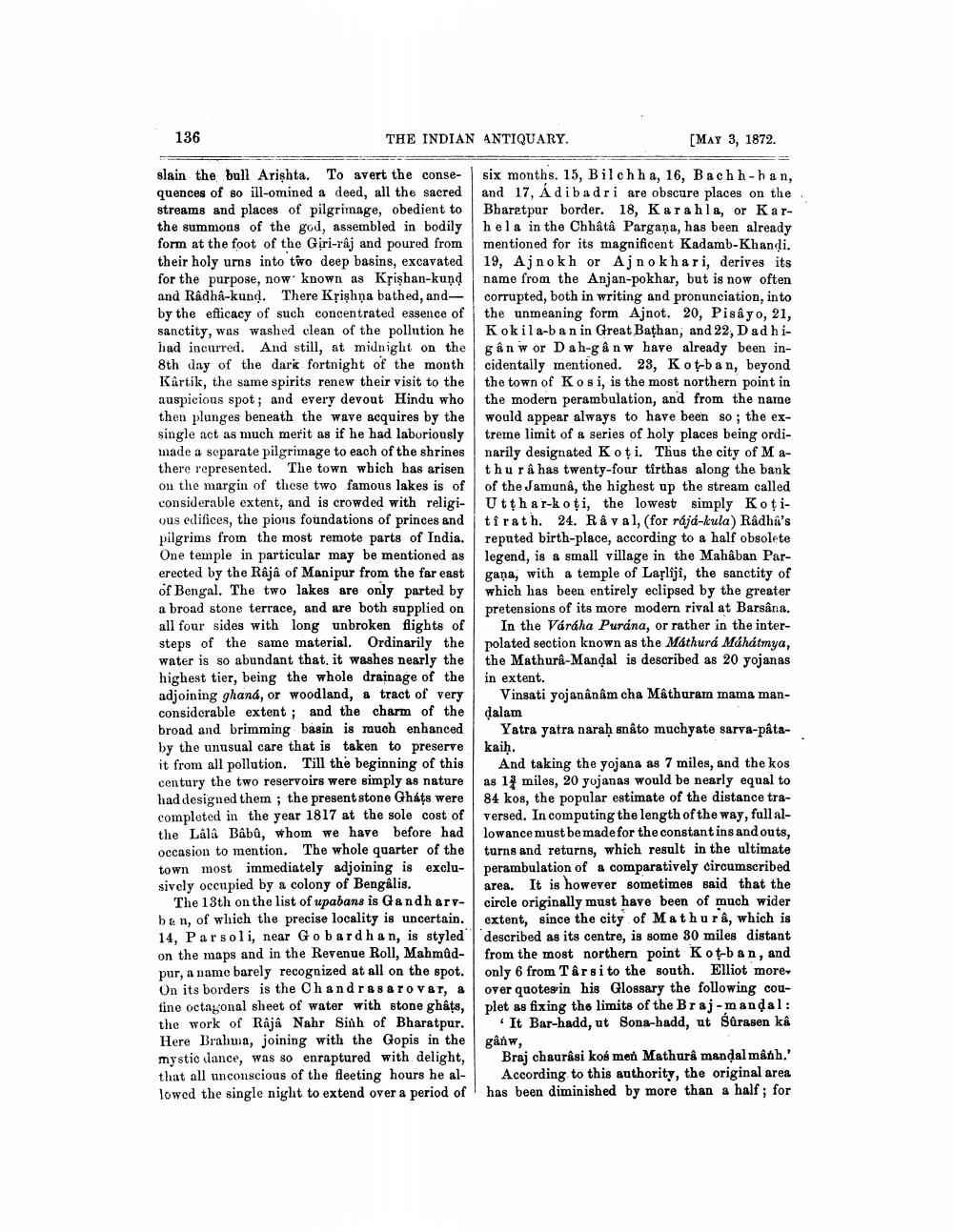________________
136
THE INDIAN ANTIQUARY.
[MAY 3, 1872.
slain the bull Arishta. To avert the consequences of so ill-omined a deed, all the sacred streams and places of pilgrimage, obedient to the summons of the god, assembled in bodily form at the foot of the Giri-raj and poured from their holy urns into tivo deep basins, excavated for the purpose, now known as Krishan-kund and Radha-kund. There Krishna bathed, and by the efficacy of such concentrated essence of sanctity, was washed clean of the pollution he had incurred. And still, at midnight on the 8th day of the dark fortnight of the month Kártik, the same spirits renew their visit to the auspicious spot; and every devout Hindu who then plunges beneath the wave acquires by the single act as much merit as if he had laboriously made a separate pilgrimage to each of the shrines there represented. The town wbich has arisen on the margin of these two famous lakes is of considerable extent, and is crowded with religi- ous edifices, the pions foundations of princes and pilgrims from the most remote parts of India. One temple in particular may be mentioned as erected by the Râjâ of Manipur from the far east of Bengal. The two lakes are only parted by a broad stone terrace, and are both supplied on all four sides with long unbroken flights of steps of the same material. Ordinarily the water is so abundant that it washes nearly the highest tier, being the whole drainage of the adjoining ghaná, or woodland, & tract of very considerable extent ; and the charm of the broad and brimming basin is much enhanced by the unusual care that is taken to preserve it from all pollution. Till the beginning of this century the two reservoirs were simply as nature had designed them; the present stone Ghats were completed in the year 1817 at the sole cost of the Lali Baba, whom we have before had occasion to mention. The whole quarter of the town most immediately adjoining is exclusively occupied by a colony of Bengalis.
The 18th on the list of upabans is Gandharvban, of which the precise locality is uncertain. 14, Parsoli, near Gobardha n, is styled on the maps and in the Revenue Roll, Mahmadpur, a name barely recognized at all on the spot. On its borders is the Chandras a rovar, a fine octagonal sheet of water with stone ghats, the work of Raja Nahr Sinh of Bharatpur. Here Brahma, joining with the Gopis in the mystic dance, was so enraptured with delight, that all unconscious of the fleeting hours he al lowed the single night to extend over a period of
six months. 15, Bilch ha, 16, Bachh-han, and 17, Á dibadri are obscure places on the Bharatpur border. 18, Karahla, or Karhela in the Chhâtâ Pargana, has been already mentioned for its magnificent Kadamb-Khandi. 19, Ajnokh or Ajnokhari, derives its name from the Anjan-pokhar, but is now often corrupted, both in writing and pronunciation, into the unmeaning form Ajnot. 20, Pisayo, 21, Kokila-b a n in Great Bathan, and 22, Dadhigân w or D a h-g â nw have already been incidentally mentioned. 23, Kot-ban, beyond the town of Kosi, is the most northern point in the modern perambulation, and from the name would appear always to have been so; the extreme limit of a series of holy places being ordinarily designated Koţi. Thus the city of Mathu r å has twenty-four tirthas along the bank of the Jamuna, the highest up the stream called Utthar-koti, the lowest simply Koţitîrath. 24. Raval, (for rájá-kula) Râdha's reputed birth-place, according to a half obsolete legend, is a small village in the Mahâban Pargana, with a temple of Lapliji, the sanctity of which has been entirely eclipsed by the greater pretensions of its more modern rival at Barsana.
In the Váráha Purána, or rather in the interpolated section known as the Máthurá Máhátmya, the Mathura-Mandal is described as 20 yojanas in extent.
Vinsati yojanânâm cha Mathuram mama mandalam
Yatra yatra naraḥ snato muchyate sarva-pâta
And taking the yojana as 7 miles, and the kos as 14 miles, 20 yojanas would be nearly equal to 84 kos, the popular estimate of the distance traversed. In computing the length of the way, full allowance must be made for the constant ins and outs, turns and returns, which result in the ultimate perambulation of a comparatively circumscribed area. It is however sometimes said that the circle originally must have been of much wider extent, since the city of Mathura, which is described as its centre, is some 80 miles distant from the most northern point Kot-ban, and only 6 from Tarsi to the south. Elliot more, over quotes in his Glossary the following couplet as fixing the limits of the Braj-mandal:
It Bar-hadd, ut Sona-hadd, ut Sarasen kê gånw,
Braj chaurasi kosmen Mathurâ mandal manh.'
According to this authority, the original area has been diminished by more than a half; for




